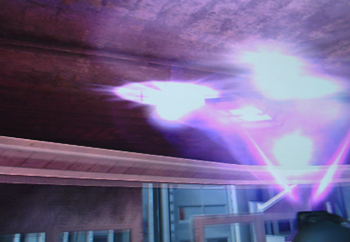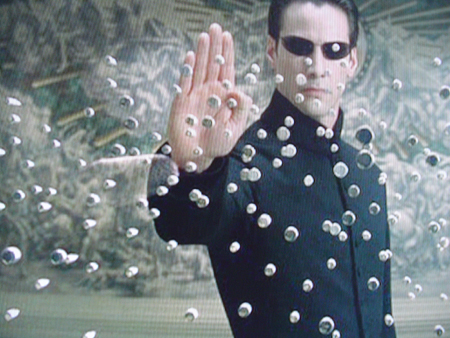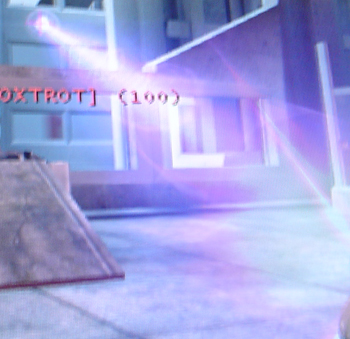A Guide to Choosing the Right 19" LCD Monitor - 7 Models Reviewed
by Kristopher Kubicki on November 30, 2004 12:04 AM EST- Posted in
- Displays
Application Analysis
The core of our LCD benchmarking comes from real application analysis. We play with a lot of monitors and it gets easier for us each time to pick out problems with an LCD just by using the right application. Here are a few quick looks at some demanding full screen applications. We already ran ColorVision's OptiCal software, so all of our monitors are calibrated and adjusted to the same curves.High Definition Video - We cheated a little bit on this portion of the analysis and handicapped all the monitors. None of these LCDs can display a true HD signal correctly without compressing pixels or cropping the image. Nevertheless, we set out to play a WMV9 1080i signal on our monitors with the interest in looking for color differences. Since our monitors have all been precalibrated, we expect the same image on each screen. Unfortunately, no amount of calibration can fix some things; we still noticed "off" reds on most of the monitors (including the Samsung 193P, the Sony, the Planar and the Dell). The BenQ, NuTech and ViewSonic occasionally managed to wash out blues a little too easily, and when looking in the right places, we could easily spot some of the differences between the 6-bit BenQ image.
The Matrix Reload, The Matrix - We use the Matrix series to test full motion video on our LCDs. Since the Matrix isn't the best movie to test color reproduction, we typically only look for motion blur or other imperfections. As expected, we noticed no fatal flaws in any of the LCDs. Although, while running some of them side by side, it became readily apparent that some monitors put a slight hint of color on the application - noticeably, the NuTech and ViewSonic monitors had a slight bluish tint.
WarHammer 40K, Dawn of War - When looking for a monitor's response time, we generally only consult first-person shooters for reference. However, those of you who have played a fast-paced game of Warcraft III or NeverWinter Nights will know that scrolling around for hours puts a severe tax on the monitor. Although we didn't notice any profound difference on the 16ms BenQ monitor, we could tell that the Sony and Planar had occasional difficulty in poorly lit areas of the game. For example, when scrolling around the last level of DOW where the majority of the level is gray ash and black soot, we would see the edge of the menu bar and status icons bleed into the ground.
Looking closer, we noticed some small differences with heavy weapons fire while scrolling on the BenQ FP931 and Samsung 193P. With enough patience, we can actually count the tracers shot over long distances, but when viewing the same scene on the Planar PE191M, the same task seems almost impossible. Attempting to do the same on the ViewSonic LCD proves futile sometimes, but not others.
Max Payne 2 - The extreme light and dark transitions in Max Payne still provide us with the sufficient criteria to benchmark transient response time; specifically, we can focus on the light and dark extremes. However, in all of the demos that we ran, we noticed virtually no difference from one monitor to another. The Samsung 193P looked a little more vibrant than its competitors, but the NuTech and ViewSonic models were displaying particularly brighter lights while maintaining the same dark hues as the SyncMaster 193P. Revisiting Max Payne with the Dell 2001FP was a little bit of a surprise. Even with the brightness set to its maximum, we were a little surprised at how much brighter the 19" LCDs were running.
Halo, Unreal Tournament 2004 - Halo and UT2K4 have very similar results, but now, we are looking for fast motion and color correctness at the same time. Again, we noticed a slightly blue tint to the BenQ monitor even after it was corrected with OptiCal. All of the monitors had a tendency to wash out, particularly in bright areas, and part of that is because we are running all of our monitors at the highest brightness levels. Specifically, the BenQ and Samsung 910V would wash out especially in bright explosions (a well-placed Redeemer usually did the trick). On occasion, the Sony SDM-934 and the Planar PE191M would blur in heavy laser battles (4 or 5 shock rifle shots firing across the screen would usually leave a small trail).

ViewSonic Q190MB
Click to Enlarge.














97 Comments
View All Comments
nullpointerus - Friday, December 3, 2004 - link
So you mean that only _some_ LCD's with that resolution are physically 5:4? LOL, I just couldn't resist it. Sorry I missed your previous post!GOSHARKS - Thursday, December 2, 2004 - link
As I had previously stated (#61,62) - ALL computer LCD's with a resolution of 1280x1024 are PHYSCIALLY 5:4. You will not find a 1280x1024 LCD on the market that is physically 4:3. Kristopher Kubicki really needs to address this in an amendment to his article.nullpointerus - Thursday, December 2, 2004 - link
Keep in mind now that most cards are dual-capable, you could keep your CRT for games and get the LCD for word processing - to decrease eye strain. Not only that, but you could watch TV on the CRT while you're working, or keep two documents visible at the same time, etc.archcommus87 - Thursday, December 2, 2004 - link
Thanks for the info.That's a major turn off for any LCD for me, then. I wouldn't mind running my desktop in 1280x1024 if the monitor itself had a 5:4 ratio, but having to scale my games or run them in a smaller screen would annoy me. Right now I run HL2 in 1280x960 plenty smoothly, but I won't necessarily ALWAYS be able to run the newest games in that high of a resolution.
nullpointerus - Thursday, December 2, 2004 - link
Oh, I might also have mentioned why LCD's are different than CRTs.A LCD produces its image via millions of fixed-size, fixed-position cells that are manipulated with some kind of electrical charge to produce colors which collectively form an image. When the image size isn't exactly the same size as the number of cells, some algorithm has to be applied to scale the image up/down before it can be displayed. There's no physical distortion, but you may get stuck pixels, gamma problems, and streaking.
A CRT produces its image via an electron gun which continually blasts the screen with lines of colors (basically) y*r times per second, where y is the vertical resolution and r is the vertical refresh rate. The size, shape, etc. of these lines are configurable so they can be very easily stretched and manipulated without by changing the focus and interval of the beams. So there's no scaling algorithm per se, but then again you get convergence problems (i.e. where the RGB beams go out of sync with one another), physical distortions (i.e. rounded/skewed/pincushioned image).
That's why LCDs have a "native" resolution while CRTs just have a kind of a maximum firing rate which is usually referred to in terms of a "pixel clock." So in a sense you could say that all of a CRT's supported resolutions are "native."
nullpointerus - Thursday, December 2, 2004 - link
archcommus87:1. It depends on the LCD in question, methinks. Some searching for specifications by the model number of the LCD that you are searching for will usually turn up its aspect ratio. Try to corroborate information from several sources (especially the manufacturer's website if possible) since the stores can get the specs wrong.
2. LCDs run in their native resolution. If that's 1280x1024, it will always "run in" 1280x1024 no matter what resolution your video card is feeding it the video data. There are several ways that lower-than-native resolutions can be handled, depending on your video card's drivers.
AFAIK, the default way is to simply use monitor scaling. For example, if you run a game at 800x600, your flat panel will extrapolate this up into an 1280x1024 image, which makes it look rather blurry. Scaled graphics will probably just look "different," but scaled text will appear fuzzy.
There's also cropping, which will just use the center 800x600 pixels for example and set the others to black. So you get a smaller picture than if you had let the monitor scale it up, but on the other hand it will also be clearer. This might also be called "centering."
IIRC, nVidia has more options in this respect than ATI, but that might depend on the model of your card as well. Maybe look in your video driver help files or ask around to see what your video card supports.
archcommus87 - Thursday, December 2, 2004 - link
No one has provided a clear answer on this, can someone please do so?We know 1280x1024 is 5:4. So are the LCDs actually 5:4 in physical size or are they 4:3 like a CRT? I keep hear differeing opinions. Or is each brand different?
Second, how do LCDs respond when you change the resolution to something other than native? Does everything look garbled and crappy or is it okay as long as you keep your ratio? The reason I ask is because if I had a 19" LCD running at 1280x1024 resolution, I don't think I'd *always* want to run my games at that high of a res.
comomolo - Thursday, December 2, 2004 - link
Hey, Anandtech, I usually trust your reviews, but should I read further when you state that 17 and 19 inches monitors put 5:4 aspect ratios into 4:3 boxes? Or when you compare CRTs capable of much higher resolution than that of the 17 and 19 inches LCDs. An apples to apples comparison would show you LCDs are still much more expensive than comparable CRTs.Toadster - Wednesday, December 1, 2004 - link
why no review of the DELL 1905? i mean, DELL reigned in the 20+ review why not the 19?deathwalker - Wednesday, December 1, 2004 - link
The Dell 2001FP is only $799 for those that don't shop smart..I bought mine several weeks ago and only paid $639 for it. I love it and have no regrets even after this article. Im runnin a 1600x1200 desktop..something none of these other monitors can do.